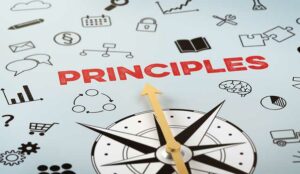Tamsin Dollin at NICE outlines the nine principles companies should live by when improving customer journeys.
There will always be a need to improve customer journeys, whether you’re Apple, or a small business, or a public sector agency trying to make experiences smoother for citizens.
Whoever coined the phrase “customer journeys” was brilliant. Just think about a road trip across your state or country. Stretches of the road are smooth, but some are full of potholes.
Cities you pass have sections that are worn down and some that are shiny and new. You might be faced with confusing roundabouts and terrifying mergers onto busy highways.
A customer of a business that hasn’t optimized its customer journeys can experience something very similar to your road trip.
Maybe the online shopping experience is smooth until customers arrive at a checkout process full of potholes. Or self-service is as confusing as a traffic circle.
And maybe retail stores are the shiny parts of town customers look forward to visiting while customer service is the bad neighborhood people try to avoid.
While disjointed experiences may be understandable and even add a little flavor during road trips, customers won’t tolerate them for long when they’re trying to transact with a business or need help.
Organizations need to provide a consistent and high-quality experience across the entire journey. Filling potholes and cleaning up blight takes a principled approach to improving and optimizing customer journeys.
What are Customer Journeys?
Customer journeys are the different paths your customers follow while trying to accomplish goals with your business. Goals can include making a purchase, finding out information, getting help, and more.
These goals create different journeys. For example, a customer who wants to purchase your product online would follow a different path than a customer looking for warranty information.
Customer journeys are composed of multiple touchpoints and handoffs. A touchpoint is any moment across the customer journey when a consumer comes into contact with your business.
Examples of touchpoints include marketing emails, contact centre interactions, and your website. Handoffs are the transitions between touchpoints, similar to merging onto a highway during a road trip. Transitioning from one touchpoint to the next should be smooth and effortless, not scary or frustrating.
Because of the explosive arrival of so many digital channels, customer journeys are no longer linear. One person could take a path that includes five digital touchpoints before he makes an online purchase, while another one could simply walk into a store to buy the product he wants.
The complexity of modern journeys has made it more important than ever to manage and optimize them.
What Methods Can Businesses Use to Improve Customer Journeys?
As customer journey management has evolved, so have the methods used to improve customer journeys. The following are some of the more effective ways to improve the end-to-end journey.
Customer Experience Management (CEM) Programs
Customer experience management programs are a formal and structured way to manage CX across the entire journey. Effective CEM relies on a thorough understanding of customers and the paths they follow as they try to accomplish a particular goal with a company.
Data and employee behavior are the foundation of successful CEM programs. To make data-driven decisions, CEM teams collect different types of customer information from multiple sources, including contact centre data, product reviews, social media comments, blog posts, survey and focus group results, and other sources of valuable information.
This collection of data unearths pain points that need attention as well as moments of delight that probably shouldn’t be tinkered with.
CEM programs also rely on changes in employee behavior to drive meaningful, lasting change. Every employee needs to align on CX goals that will improve customer journeys, but frontline employees such as customer service agents are positioned to make the greatest impact.
Customer Journey Maps
Customer journey maps are essential tools for managing and improving customer journeys. A customer journey map is a visual representation, such as the one below, of the different paths customers follow when they transact or interact with a business.
Maps can take different forms, but they all need to include essential information such as touchpoints, customer goals, operational data, customer input, and more.
Maps should have enough information that users can identify potholes as well as smooth stretches of highway.
Because it would be impossible to map every customer journey, businesses often focus on the most common ones, and they may use customer personas to identify which journeys to map.
According to one study, 71% of businesses that use customer journey mapping say the process improved customer satisfaction. Additionally, in a survey of CX professionals, 26% reported that customer journey mapping was their top investment priority.
Organization Structure Changes
In a survey that asked about challenges to optimizing customer journeys, the top challenge, cited by 39.9% of businesses, was lack of inter-departmental collaboration.
Substantial customer journey transformations can require multiple business teams to change policies, processes, and systems.
Telling the marketing team that the frequency of their promotional emails is becoming spammy can be . People get defensive and territorial when you critique their work, resulting in lack of cooperation.
To combat this type of challenge, many businesses have created Chief Experience Officer or Chief Digital Officer positions.
Elevating customer journey management and optimization to the executive level can help those responsible for improvement efforts gain the organizational buy-in needed for success.
But lack of inter-departmental collaboration isn’t the only reason businesses change their org structures to affect change.
Focusing on customer journeys as an additional duty can lead to neglect and suboptimal results. This is why businesses are forming permanent CEM or Journey Product Management teams whose sole focus is to improve customer journeys.
9 Principles That Can Lead to Better Customer Journeys
Teams that are responsible for improving customer journeys will be more successful if they have guiding principles to keep them on track. Here are nine principles you can’t go wrong with.
1. Always Look at Things From the Customer’s Perspective
This one may seem obvious, but it needs to be at the top of the list anyway. Journey maps that include customer emotions, goals, and reactions will help teams better understand customers’ perspectives.
Additionally, taking a walk in your customers’ shoes by actually following some of the more common journeys as a customer allows teams to gain firsthand experience of what customers encounter.
However, always understanding the customer’s perspective doesn’t mean taking off your business hat. Customer journey management requires organizations to balance customer demands with business objectives and budgets.
2. Focus on the End-To-End Journey, Not Just Individual Touchpoints
It can be easy to fall into the trap of making each touchpoint the best it can be while losing sight of the entire journey.
For example, if a cable provider has a ten-step installation process, every individual step can receive high quality ratings from customers, but the overall installation journey can receive negative scores if it takes too long.
Rough handoffs between touchpoints can also add friction and frustration to customer journeys. Contact centres are a primary touchpoint where bad transitions can happen.
If a contact centre isn’t able to provide omnichannel experiences, customers will be required to start from scratch when they switch channels, like online chat to voice or Messenger to email.
Our research revealed that 96% of consumers expect businesses to make it easy to switch channels, so this is a good improvement candidate for organizations that don’t have omnichannel capabilities.
3. BUT, Do Optimize Touchpoints
This isn’t contradictory with principle #2. Businesses need to optimize end-to-end customer journeys AND individual touchpoints.
Doing one without the other won’t provide the results brands are seeking. A word of caution – make sure different business teams aren’t improving “their” touchpoints in a vacuum.
Improvement efforts should move journeys towards more consistent experiences, which can be sabotaged if changes to touchpoints aren’t in sync.
4. Take an Incremental Approach
If you roll out all the improvements at once, you’ll never know which one is having the most positive or negative impact.
When possible, use A/B testing for changes to customer-facing software functionality, message copy, etc., to know the right levers to pull. This method can take longer, but it should provide better results than a “big bang” approach.
5. No Sacred Cows
In the business world, a sacred cow is an untouchable program, system, person, department, or process. They exist with unfortunate frequency because of office politics and people’s egos.
Optimizing customer journeys is an enterprise effort that can have far-reaching impacts. To make journeys the best they can be, businesses need to identify and eliminate root causes of friction and dissatisfaction.
This means nothing can be off-limits, not even the CEO’s pet project or that confusing self-service functionality the COO personally designed. (He’s so proud of that!)
6. Data, Data, Data!
Improving customer journeys should be a data driven effort. Plan on spending a great deal of time and effort on collecting and analyzing customer information – the more data you have, the better you’ll know your customers and what they need and want from your business.
Contact centres are valuable sources of data that can enlighten the entire organization about touchpoints that the different business teams should enhance.
Using survey data, results from interaction analytics, and operational data, contact centres can help bring awareness to:
- Product quality issues
- Poorly designed software functionality
- Website usability problems
- Confusing marketing messages
- Systemic billing issues
- Packaging problems
- Clumsy handoffs
- Customer sentiment
- Self-service and agent-assisted support performance
- Customer satisfaction, customer effort, and Net Promoter Scores
- And more
In short, the contact centre is a hub of information about customer journey quality, pain points, and moments of delight.
Basing decisions on data rather than assumptions or gut feelings will help ensure you’re focusing on the right journeys and improvements.
It will also help to have facts when you diplomatically tell your COO that the self-service functionality he personally designed needs an overhaul.
Customer data isn’t just essential for assessing customer journeys; it should also be part of the solutions. For example, customer information should be used to tailor recommendations and personalize experiences. Additionally, customer data and contextual information is required for omnichannel customer service experiences.
7. Proactively Shape and Control Customer Journeys
Journey management isn’t just about “paving cow paths.” Just because customers commonly follow a certain journey for issue resolution doesn’t mean it’s the best path to follow for achieving their goals.
Businesses should try to better control journeys by directing customers to the best path and nudging them to take the next step in the process.
Additionally, organizations should be proactively innovative when designing customer journeys. Journey optimization shouldn’t just be about fixing pain points. Businesses should try to reimagine commonly used journeys in order to surprise and delight their customers.
8. More Isn’t Necessarily Better
Today’s consumers want choices, but there is a point where too many choices become overwhelming. Businesses need to find and walk that fine line in order to provide the best experiences.
As an example, there’s a national food chain that is known for its huge menu. I go there because I love the food, but I always order the same thing because I find all those menu options a little intimidating.
I also don’t read articles like “The 100 Best Movies to Watch on Netflix Right Now.” One hundred options are a lot to plow through. I really just want someone to thoughtfully evaluate the movies (or whatever the list is about) and just present ten truly great options.
Many times, simple is better.
The principle of “more isn’t necessarily better” is highly relevant to contact centres. Customers do value channel choice, but businesses shouldn’t implement a bunch of channels just because they can.
Gartner found that adding too many channels just adds complexity to resolution journeys and actually increases contact volume.
Just as I would like more listicle authors to do, contact centres should thoroughly research channels and offer their customers a carefully curated group of support options.
9. Focus on High Value Customer Journeys
Because there are too many possible journeys to map, manage, and improve, businesses should prioritize journeys so they focus on ones of the highest value.
What constitutes a “high value” journey is up to the business to decide. The purchase journey is an obvious one to prioritize, but “high value” could also mean journeys that have a significant impact on customer loyalty and satisfaction.
Optimizing customer journeys is vital for competing in today’s experience economy. These nine principles will guide journey teams to success.
This blog post has been re-published by kind permission of NICE – View the Original Article
For more information about NICE - visit the NICE Website
Call Centre Helper is not responsible for the content of these guest blog posts. The opinions expressed in this article are those of the author, and do not necessarily reflect those of Call Centre Helper.
Author: NICE
Published On: 30th Jun 2022 - Last modified: 25th Apr 2024
Read more about - Guest Blogs, NICE, Tamsin Dollin






 NICE is a leading global enterprise software provider that enables organizations to improve customer experience and business results, ensure compliance and fight financial crime. Their mission is to help customers build and strengthen their reputation by uncovering customer insight, predicting human intent and taking the right action to improve their business.
NICE is a leading global enterprise software provider that enables organizations to improve customer experience and business results, ensure compliance and fight financial crime. Their mission is to help customers build and strengthen their reputation by uncovering customer insight, predicting human intent and taking the right action to improve their business. 











